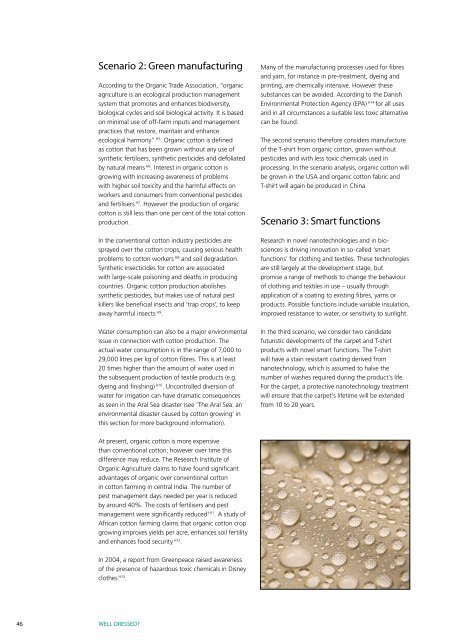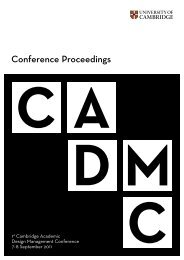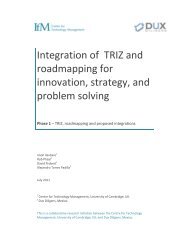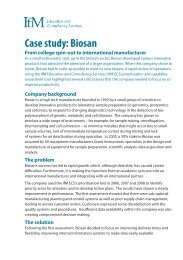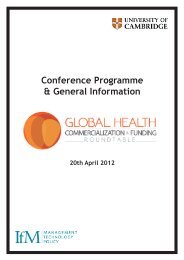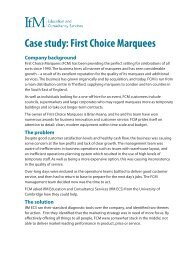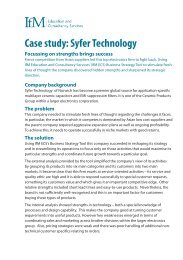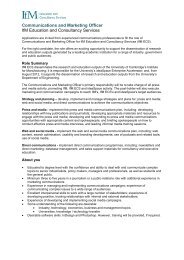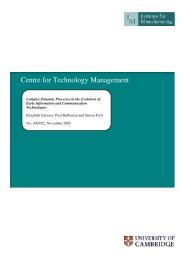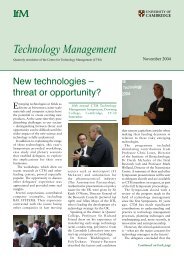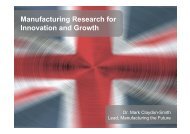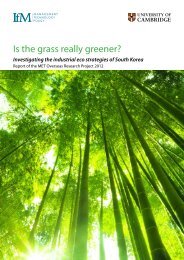The present and future sustainability of clothing and textiles in the ...
The present and future sustainability of clothing and textiles in the ...
The present and future sustainability of clothing and textiles in the ...
You also want an ePaper? Increase the reach of your titles
YUMPU automatically turns print PDFs into web optimized ePapers that Google loves.
Scenario 2: Green manufactur<strong>in</strong>g<br />
Accord<strong>in</strong>g to <strong>the</strong> Organic Trade Association, “organic<br />
agriculture is an ecological production management<br />
system that promotes <strong>and</strong> enhances biodiversity,<br />
biological cycles <strong>and</strong> soil biological activity. It is based<br />
on m<strong>in</strong>imal use <strong>of</strong> <strong>of</strong>f-farm <strong>in</strong>puts <strong>and</strong> management<br />
practices that restore, ma<strong>in</strong>ta<strong>in</strong> <strong>and</strong> enhance<br />
ecological harmony” H5 . Organic cotton is def<strong>in</strong>ed<br />
as cotton that has been grown without any use <strong>of</strong><br />
syn<strong>the</strong>tic fertilisers, syn<strong>the</strong>tic pesticides <strong>and</strong> defoliated<br />
by natural means H6 . Interest <strong>in</strong> organic cotton is<br />
grow<strong>in</strong>g with <strong>in</strong>creas<strong>in</strong>g awareness <strong>of</strong> problems<br />
with higher soil toxicity <strong>and</strong> <strong>the</strong> harmful effects on<br />
workers <strong>and</strong> consumers from conventional pesticides<br />
<strong>and</strong> fertilisers H7 . However <strong>the</strong> production <strong>of</strong> organic<br />
cotton is still less than one per cent <strong>of</strong> <strong>the</strong> total cotton<br />
production.<br />
In <strong>the</strong> conventional cotton <strong>in</strong>dustry pesticides are<br />
sprayed over <strong>the</strong> cotton crops, caus<strong>in</strong>g serious health<br />
problems to cotton workers H8 <strong>and</strong> soil degradation.<br />
Syn<strong>the</strong>tic <strong>in</strong>secticides for cotton are associated<br />
with large-scale poison<strong>in</strong>g <strong>and</strong> deaths <strong>in</strong> produc<strong>in</strong>g<br />
countries. Organic cotton production abolishes<br />
syn<strong>the</strong>tic pesticides, but makes use <strong>of</strong> natural pest<br />
killers like beneficial <strong>in</strong>sects <strong>and</strong> ‘trap crops’, to keep<br />
away harmful <strong>in</strong>sects H9 .<br />
Water consumption can also be a major environmental<br />
issue <strong>in</strong> connection with cotton production. <strong>The</strong><br />
actual water consumption is <strong>in</strong> <strong>the</strong> range <strong>of</strong> 7,000 to<br />
29,000 litres per kg <strong>of</strong> cotton fibres. This is at least<br />
20 times higher than <strong>the</strong> amount <strong>of</strong> water used <strong>in</strong><br />
<strong>the</strong> subsequent production <strong>of</strong> textile products (e.g.<br />
dye<strong>in</strong>g <strong>and</strong> f<strong>in</strong>ish<strong>in</strong>g) H10 . Uncontrolled diversion <strong>of</strong><br />
water for irrigation can have dramatic consequences<br />
as seen <strong>in</strong> <strong>the</strong> Aral Sea disaster (see ‘<strong>The</strong> Aral Sea: an<br />
environmental disaster caused by cotton grow<strong>in</strong>g’ <strong>in</strong><br />
this section for more background <strong>in</strong>formation).<br />
Many <strong>of</strong> <strong>the</strong> manufactur<strong>in</strong>g processes used for fibres<br />
<strong>and</strong> yarn, for <strong>in</strong>stance <strong>in</strong> pre-treatment, dye<strong>in</strong>g <strong>and</strong><br />
pr<strong>in</strong>t<strong>in</strong>g, are chemically <strong>in</strong>tensive. However <strong>the</strong>se<br />
substances can be avoided. Accord<strong>in</strong>g to <strong>the</strong> Danish<br />
Environmental Protection Agency (EPA) H14 for all uses<br />
<strong>and</strong> <strong>in</strong> all circumstances a suitable less toxic alternative<br />
can be found.<br />
<strong>The</strong> second scenario <strong>the</strong>refore considers manufacture<br />
<strong>of</strong> <strong>the</strong> T-shirt from organic cotton, grown without<br />
pesticides <strong>and</strong> with less toxic chemicals used <strong>in</strong><br />
process<strong>in</strong>g. In <strong>the</strong> scenario analysis, organic cotton will<br />
be grown <strong>in</strong> <strong>the</strong> USA <strong>and</strong> organic cotton fabric <strong>and</strong><br />
T-shirt will aga<strong>in</strong> be produced <strong>in</strong> Ch<strong>in</strong>a.<br />
Scenario 3: Smart functions<br />
Research <strong>in</strong> novel nanotechnologies <strong>and</strong> <strong>in</strong> biosciences<br />
is driv<strong>in</strong>g <strong>in</strong>novation <strong>in</strong> so-called ‘smart<br />
functions’ for <strong>cloth<strong>in</strong>g</strong> <strong>and</strong> <strong>textiles</strong>. <strong>The</strong>se technologies<br />
are still largely at <strong>the</strong> development stage, but<br />
promise a range <strong>of</strong> methods to change <strong>the</strong> behaviour<br />
<strong>of</strong> <strong>cloth<strong>in</strong>g</strong> <strong>and</strong> <strong>textiles</strong> <strong>in</strong> use – usually through<br />
application <strong>of</strong> a coat<strong>in</strong>g to exist<strong>in</strong>g fibres, yarns or<br />
products. Possible functions <strong>in</strong>clude variable <strong>in</strong>sulation,<br />
improved resistance to water, or sensitivity to sunlight.<br />
In <strong>the</strong> third scenario, we consider two c<strong>and</strong>idate<br />
futuristic developments <strong>of</strong> <strong>the</strong> carpet <strong>and</strong> T-shirt<br />
products with novel smart functions. <strong>The</strong> T-shirt<br />
will have a sta<strong>in</strong> resistant coat<strong>in</strong>g derived from<br />
nanotechnology, which is assumed to halve <strong>the</strong><br />
number <strong>of</strong> washes required dur<strong>in</strong>g <strong>the</strong> product’s life.<br />
For <strong>the</strong> carpet, a protective nanotechnology treatment<br />
will ensure that <strong>the</strong> carpet’s lifetime will be extended<br />
from 10 to 20 years.<br />
At <strong>present</strong>, organic cotton is more expensive<br />
than conventional cotton; however over time this<br />
difference may reduce. <strong>The</strong> Research Institute <strong>of</strong><br />
Organic Agriculture claims to have found significant<br />
advantages <strong>of</strong> organic over conventional cotton<br />
<strong>in</strong> cotton farm<strong>in</strong>g <strong>in</strong> central India. <strong>The</strong> number <strong>of</strong><br />
pest management days needed per year is reduced<br />
by around 40%. <strong>The</strong> costs <strong>of</strong> fertilisers <strong>and</strong> pest<br />
management were significantly reduced H11 . A study <strong>of</strong><br />
African cotton farm<strong>in</strong>g claims that organic cotton crop<br />
grow<strong>in</strong>g improves yields per acre, enhances soil fertility<br />
<strong>and</strong> enhances food security H12 .<br />
In 2004, a report from Greenpeace raised awareness<br />
<strong>of</strong> <strong>the</strong> presence <strong>of</strong> hazardous toxic chemicals <strong>in</strong> Disney<br />
clo<strong>the</strong>s H13 .<br />
46 WELL DRESSED?


